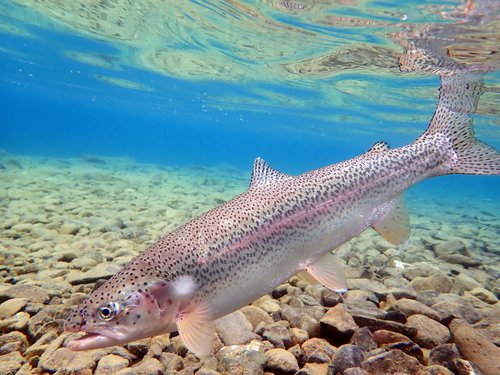
Rainbow Trout
The Atlantic Bluefin Tuna (Thunnus thynnus) is a highly migratory, large pelagic fish renowned for its size, speed, and commercial value. As one of the largest bony fishes, it plays a critical role in the marine ecosystem. The species has long been prized for its meat, especially in sushi and sashimi, leading to significant fishing pressure.
4 11 years
Lifespan
40 - 70 cm
Length
Least Concern
Conservation Status
29 km/h
Swimming speed
Omnivorous, Insectivorous
Diet
Diadromous Migration - Anadromous, Local Migration
Migration
Appearance Overview
The Atlantic Bluefin Tuna is renowned for its large, streamlined body, built for speed and endurance in the open ocean.
Coloration
Dark metallic blue above, shading to silvery white below
Fins
Two dorsal fins; the first is yellow or bluish, the second is reddish-brown
Body Shape
Torpedo-shaped, with a relatively slender caudal peduncle (the narrow part of the body just before the tail fin)
Length
Commonly up to 6.6 ft (2 m), can reach up to 13 ft (4 m)
Weight
Typically up to 550 lbs (250 kg), maximum recorded weight is 1,496 lbs (679 kg)
Diet
Carnivorous, feeding on a variety of fish (such as herring, mackerel, and hake), squid, and crustaceans
Feeding Behavior
Highly active predators, they use their speed and agility to chase down prey. They often feed cooperatively, especially when hunting schooling fish.
Social Behavior
Forms large schools, particularly during migration and spawning. Schooling behavior is thought to aid in both hunting and protection from predators.
Commercial Relevance
Extremely high value, particularly in the sushi and sashimi markets of Japan. This demand has driven extensive fishing pressure.
Conservation measures
International fishing quotas and regulations managed by organizations like ICCAT (International Commission for the Conservation of Atlantic Tunas), along with efforts to implement more sustainable fishing practices.
Status
Endangered (IUCN)
Threats
Overfishing has been the primary threat, significantly depleting populations. Illegal and unreported fishing also contribute. Climate change may affect their prey distribution and spawning grounds.
Habitat Distribution
Depth Range
Surface waters to depths of over 3,280 feet (1,000 meters)
Geographic Range
Widely distributed in the North Atlantic Ocean, including the Mediterranean Sea. They are found from Newfoundland to the Gulf of Mexico in the west, and from Norway to the Canary Islands and the Mediterranean Sea in the east.
Preferred Environment
Primarily pelagic (open ocean), but they also venture into coastal waters. They prefer temperate waters.
Reproduction and Life Cycle
Breeding Habits
Spawns in warm waters, with two main spawning grounds: the Gulf of Mexico and the Mediterranean Sea. Spawning typically occurs from April to June in the Gulf of Mexico and from May to July in the Mediterranean.
Development Stages
Eggs are pelagic (free-floating). Larvae develop rapidly, feeding on plankton. Juveniles grow quickly, forming schools and migrating extensively.
Fecundity
Highly fecund; a single female can produce up to 30 million eggs per spawning season.
Maturity Age
Reaches sexual maturity relatively late, at around 4-8 years of age in the western Atlantic and slightly earlier in the eastern Atlantic.
Faqs about Rainbow Trout
Where are Atlantic Bluefin Tuna found?
Atlantic Bluefin Tuna are found across the Atlantic Ocean, from the eastern coast of North America to the Mediterranean Sea.
How long do Atlantic Bluefin Tuna live?
They can live up to 40 years, though many do not reach this age due to fishing pressure.
Are Atlantic Bluefin Tuna warm-blooded?
Yes, they are warm-blooded, which helps them maintain high activity levels in cold waters.
What are the natural predators of the Bluefin Tuna?
They are apex predators, meaning they are at the top of the food chain. Their only natural predators are very large sharks, orcas, and other large marine animals.
Why are Bluefin Tuna so expensive?
The high demand, combined with the relatively slow growth and maturation rate of the species, makes them very expensive.
Copyright @ Nature Style Limited. All Rights Reserved.
 English
English